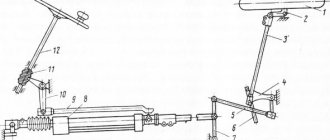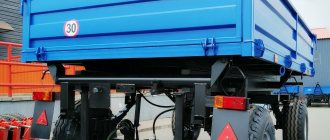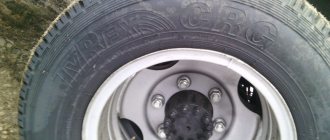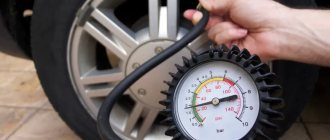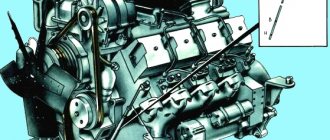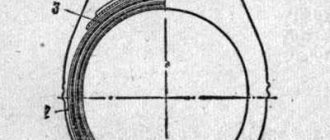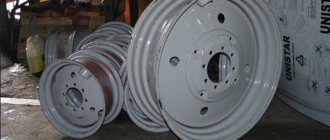Publication date: 06/08/2018
PAZ-4234 is one of the most common domestically produced buses. It is well adapted to Russian roads, simple and reliable in operation, and ensures the economic feasibility of passenger transportation. PAZ-4234 is a model created on the basis of PAZ-3205. It differs from its predecessor in having an elongated body. The length of the new model exceeded that of the old bus by 1 m 16.5 cm. The equipment belongs to the middle class, has a total capacity of 50 passengers, 30 seats. The spacious interior and robust design, ensuring the safety of passenger transportation, allow this equipment to be successfully used for travel along cramped streets of megacities and suburban routes.
History of creation
The new model PAZ-4234 was first presented in 2002 at the 70th anniversary of the Pavlovsk Automobile Plant. It was created by lengthening the PAZ-32053 model by one section. After design improvements and the creation of a complete set of technical documentation, mass production of the model began in 2003. Technical features of the 2003 car:
- diesel unit MMZ-245.9, power - 136 hp. With.;
- brakes - drum type with dual-circuit pneumatic drive and Knorr Bemse anti-lock system;
- bridge - KAAZ;
- rigid spring-type suspension.
Results of modernization carried out in 2007:
- increase in operational period and reliability;
- increasing the comfort of the driver's seat;
- improvement of interior design - installation of an incomplete partition between the driver's seat and passenger seats, upholstery of seats with artificial leather, installation of a protective door strip;
- addition of light green, beige, light gray to the body color scheme.
In 2011, models began to be equipped with engines that meet Euro-4 environmental standards.
Modifications of PAZ-4234
PAZ designers are constantly improving equipment, releasing new modifications designed for general or highly specialized applications. Therefore, spare parts should be sought for a specific version.
PAZ-423470-04. This is a school bus designed for suburban use. The cabin has 31 seats - for two adults and 29 children. Luggage shelves allow you to place backpacks and other items. The seats with seat belts installed on the podium are soft and turned to one side. The equipment is equipped with external and internal speakerphone. The package includes speed limiting devices and automatic signaling when the vehicle moves backwards.
PAZ-4234-05 (Cummins). The equipment is designed for travel in megacities and to nearby settlements. Handrails for standing passengers are located throughout the cabin. In the basic configuration, the Cummins diesel engine is equipped with an autonomous Webasto-type pre-heater, which allows convenient use of the vehicle in winter temperature conditions. Eco-safety standard - Euro-5.
PAZ-4234-04. Designed for use on urban and suburban routes. Semi-soft seats with a low back or high, separately located ones can be installed. The second option is especially convenient on long trips. Urban models have two storage areas and two doors. The presence of a pre-heater greatly facilitates the operation of equipment in winter conditions. The buyer can order increased interior comfort.
Models of the northern version have double glazing and the interior is insulated.
Specifications
Initially, the PAZ-4234 model was equipped with an MMZ-D-245 engine from the Minsk Motor Plant. A more powerful option is the YaMZ-534 diesel engine. The most powerful, cost-effective and most expensive is the Cummins engine made in the USA. Other main components included in the bus structure:
- Gearbox - five-speed manual;
- power steering;
- suspension - rigid spring;
- pneumatic dual-circuit braking system equipped with ABS.
Specifications:
- weight - 6640 kg;
- maximum permissible weight - 10500 kg;
- wheel formula - 4×2;
- drive - rear;
- The arrangement of passenger seats in the PAZ-4234 is unidirectional;
- fuel tank volume - 105 l;
- maximum speed - 95 km/h;
- The average diesel fuel consumption at partial load is 18.4 liters, at maximum - 23-24 liters.
Dimensions:
- length - 8 m 16.5 cm;
- width - 2 m 530 cm;
- height - 2 m 96 cm;
- wheelbase - 4 m 34.5 cm;
- the minimum turning radius is 9.3 m.
Filling volumes and recommended operating materials
Fuel tank: PAZ-3205 - 105 l; PAZ-3206 - 150l, gasoline A-76; cooling system - 25l, water or antifreeze A-40; engine lubrication system - 10 l, all-season M-8B, or M6/10B, winter ASZp-6; steering gear housing 1.5 l, TAP-15V; power steering system - 3.2 l, all-season oil grade P, substitutes: turbine grade T in summer, spindle AU in winter; gearbox - Zl, TAP-15V or TSp-15K; transfer case - 1.5 l, TAP-15V or TSp-15K; rear axle housing - 8.2 l, TSp-14gip; front axle housing - 7.7 l, TSp-14GIP; hydraulic brake and clutch drive system - 1.47 l, Tom brake fluid; shock absorbers - 4×0.475 l, AZh-12T; windshield washer reservoir - 2 l, NIISS-4 liquid mixed with water; brake system freeze guard - 0.2 l, industrial alcohol.
Weight of units (in kg) Engine with equipment and clutch - 304,
cardan shafts: PAZ-3205-27, PAZ-3206-41.5,
gearbox - 56, transfer case - 48.5,
front axle: PAZ-3205 - 195; PAZ-3206 - 365,
rear axle - 270, body - 2100, wheel and tire assembly - 80, radiator - 18.5.
PAZ 3205 is equipped with different types of domestic and foreign gasoline engines. The new modifications achieve fuel savings of 2-3 liters per 100 km. The total fuel consumption of new modifications of the bus is 18 liters if the equipment operates in a mixed cycle. In the urban cycle, consumption is 20.5 liters. The capacity of the standard fuel tank is enough for a trip of 500 kilometers without the need for intermediate refueling.
The bus has a pneumatic braking system. Some modifications are marked by the presence of a pneumatic-hydraulic braking system equipped with dual-circuit ABS. The PAZ 3205 is controlled by the MAZ 64229 steering system with a standard hydraulic booster. At the same time, a fully loaded bus can reach a speed of 100-120 kilometers per hour.
tel. MTS: 8916 1199908;
from 10:00 to 16:00 without lunch. Sunday and Monday are closed.
Advantages
PAZ-4234 buses are equipment that is widely in demand for operation on Russian roads, thanks to:
- improved technical characteristics;
- Possibility of operation on urban and suburban routes;
- high maintainability and availability of spare parts anywhere in the Russian Federation;
- suspension reliability even in difficult road conditions;
- affordable cost and quick payback period with active use for passenger transportation.
We have long wanted to test the most “people’s” bus, PAZ-3205. Since Soviet times, the main consumers of the PAZ-3205 were villagers who used these buses to travel from remote villages to regional centers. Various modifications of the PAZ-3205 are widely used for transporting construction workers, factory workers, and shift workers at oil and gas developments. In small towns, “pasikis,” as they are affectionately called by people, operate regular buses. Even beyond the Arctic Circle they have found application. And recently they have mastered another “profession” - minibus taxi in large cities. So the PAZ-3205 is a popular and truly “people's” bus. What are the buses of the Pavlovsk plant?
Many of our readers were probably surprised by the question posed - “grooves” have been coming off the assembly line for a long time, and have been used by numerous customers for many years. And why test buses that everyone already knows? One could agree, but...
About six years ago we had the opportunity to become closely acquainted with two “grooves” - diesel and gasoline. The cars were new, smelling of paint and had virtually no mileage. There were, frankly, a lot of problems with them; my head was spinning. For example, during maneuvers on the turning loops of the testing ground's dynamometer road, the side glass of one of the buses fell out of the opening (the opening turned out to be larger than the glass itself). On one of the buses the gearbox gears were difficult to engage, and we were unable to engage one of the gears. The outside mirrors were poorly secured and fell off due to vibration. In short, six years ago there were more than enough defects. So I wanted to see whether the “people’s” buses have changed for the better during this time or not?
Types and purpose
Tires for PAZ or any other bus can be classified into three different categories:
- depending on the tread pattern, regional, highway and road varieties are distinguished;
- based on the design, diagonal and radial products are distinguished (depending on the direction of the cord threads);
- Depending on the axial fit, tires are distinguished for the front axle, rear axle, and also universal analogues.
Tires for PAZ, as well as tires for other brands of buses in catalogs, as a rule, are allocated to a separate group. Many world-famous brands develop and produce tires designed separately for urban, suburban and intercity routes. City tires are subject to special operational requirements, since they are subject to a number of loads:
- frequent braking and acceleration;
- increased risk of cuts and chips;
- regular contact with curbs;
- frequent turns;
- unstable load due to increased passenger traffic density during peak hours.
Manufacturers are introducing many effective solutions and technologies that allow you to confidently drive passenger vehicles in any weather conditions and on any roads. Such solutions include lugs, reinforced sidewalls, transverse grooves, various tread patterns, longitudinal drainage channels, different blocks of longitudinal ribs, narrow sipes of variable depth and much more.
PAZ-32053 with a gasoline engine ZMZ-5234.10
It is probably incorrect to compare the car of today with its “brother” from six years ago in terms of power unit. At that time we were dealing with a completely new car, the same sample had been tested a long time ago, and all the “childhood diseases” were eliminated by the PAZ drivers during operation.
The engine idles quietly. The noise is created only by the pneumatic compressor, and the squelching sound of the operating compressor is similar to the squealing of a black grouse. But when the engine speed increases, a characteristic sound appears, somewhat reminiscent of the operation of the engine of an old GAZ-53 truck. Naturally, in this case you can no longer hear the pneumatic compressor.
The starting dynamics of the petrol PAZ are quite good - the engine power is still 130 hp. With. The gearbox engaged in gears without problems, except for two – fifth and reverse. For some reason, the fifth gear was engaged all the time with a “breakdown”, i.e. with a slight grinding sound, the reverse gear was also difficult, but for a different reason - there was not enough space.
And the road dynamics of the PAZ-32053 are good. To my surprise, the gas pedal worked without problems: like on imported cars, without delays and smoothly. Therefore, it was not difficult to maintain a constant speed during fuel consumption measurements.
Until 2003, PAZ buses were equipped with a braking system consisting of two circuits: hydraulic and pneumatic, like on trucks from the Gorky Automobile Plant. Since 2003, Pavlovsk residents have modernized the braking system, and it has become completely pneumatic, which made it possible to install ABS from Knorr-Bremse.
But the location of the brake pedal remains inconvenient: it is installed at different levels with the gas pedal.
The hydraulic clutch pedal is poorly positioned - very high. In city traffic jams, when the driver constantly keeps his foot on the clutch pedal, the inconvenience turns into leg pain. By the way, our version is also confirmed by the drivers of PAZ “route” taxis operating in cities. On suburban routes, PAZ drivers do not have this problem: they don’t have to keep their foot on the clutch pedal for long.
As for maneuverability, Pavlovsk buses have always been distinguished by good handling and maneuverability. Suffice it to say that with an overall turning radius of 8.5 m, the bus turns on a road 6 m wide in two steps. It should be noted that the power steering worked well - with such a turn, you had to turn the steering wheel in place. On a gasoline “groove” the power steering worked silently and easily.
Bus tire pressure
Publication date: 07/20/2021
The main task of the wheels of any vehicle is maximum traction with the road surface. The pressure in the tires of a bus, as well as any trucks and cars, is determined by the density of the air inside the tire. Insufficient or, on the contrary, excessive air density leads to a reduction in the contact patch and disruption of the optimal distribution of the bus’s mass along the axles, which in turn leads to uneven tread wear and deterioration in handling.
In addition, poor pressure negatively affects driving confidence and also poses a threat to the health and life of the driver, passengers and other road users. That is why the pressure in bus tires is the most important characteristic that requires regular monitoring.
Unlike passenger cars, tires on buses are made taking into account a number of factors:
- regular driving on bad roads or off-road;
- uneven loads due to high passenger flows during peak hours;
- frequent maneuvers, acceleration and braking;
- increased risk of chips and cuts;
- regular contact with curbs.
But if a manufacturer can develop strong and practical tires, then the driver or mechanic in the bus fleet still has to monitor the pressure in the tires of the bus.
PAZ-32053-07 with a Minsk diesel engine
Everything that has been said about the design and layout of a bus with a gasoline engine is fully true for a car with a diesel engine. The main difference is the Minsk-made MMZ D-245.7 engine. It’s hard not to notice him when standing next to a bus with its engine running. You can immediately say: “He! Tractor "Belarus". PAZ specialists worked for a long time to reduce the noise of not only the engine, but also the entire bus as a whole, and as a result, its level was brought to the required certification standards, but the feeling of a tractor engine remained.
Inside the cabin, the engine is not very noisy, especially in comparison with the diesel PAZ six years ago. On that bus you had to talk with your voice very loud.
It cannot be said that a diesel car is significantly different from a gasoline car in terms of dynamic performance. But its fuel consumption is significantly lower, which has a very good effect on the profitability of the bus.
Technical characteristics of buses PAZ-32053, PAZ-32053-07, PAZ-4234
What’s most interesting is that the PAZ-32053-07 and PAZ-4234, which corresponds to the middle class and has a more powerful MMZ-245.9E2 diesel engine, have very similar fuel consumption figures. Please note that the motor is positioned as meeting Euro 2 environmental standards.
The extended bus is also equipped with a Zilov-made, but reinforced axle ZVL-433100 (RZAA) and a “Zilov” 5-speed manual gearbox made by the Smolensk plant, as on previous models.
Naturally, the “long” PAZ has slightly worse dynamics than its “short” counterparts, but the passenger capacity is 50 people, i.e. 10...11 people more than the small class PAZs. The car has rationally arranged passenger seats, and storage areas are organized opposite the two doors with pneumatic drive.
Of course, on this “groove” it will no longer be possible to turn around in two steps on a road 6 m wide, since its length is 8.2 m, and the outer turning radius is 8.7 m, i.e. you can’t maneuver much in the city. His element is country routes, especially rural ones.
In conclusion, I would like to note that the specialists of the Pavlovsk Bus Plant have made a big step forward in six years. New PAZ-4230 “Aurora” buses of various modifications with a rear-mounted power unit are already running on the roads of the country. In the center of Moscow, passengers are served by low-floor PAZ-3237; New front-engine small class buses PAZ-3203 and PAZ-3204 are being produced in small batches and undergoing certification tests. In general, PAZ does not stand still, but is systematically integrated into the modern Russian bus market with its new model range. However, the old PAZ model and its modifications are still in demand on the market. The “people's” bus continues to be purchased for use in a wide variety of road and climatic conditions. The forecast for the future is this: the car will be in demand for a long time, especially since work on its development has never stopped. Despite its outdated design, Russians like the PAZ-3205. And we can’t sell it to Germany, Spain, Sweden or Finland. There are enough of their own “people’s” buses there even without “grooves”.
Test results of buses PAZ-32053, PAZ-32053-07, PAZ-4234
Atmospheric conditions during testing
| Air temperature, °C | + 15 |
| Wind speed, m/s | 1. 3 |
| Atmospheric pressure, hPa | 982. 996 |
| Relative humidity, % | 48. 77 |
The tests were carried out on a dynamometer road in accordance with the methodology set out in GOST 20306–90 and GOST 22576–90.
Testing and operating tips
In the Russian Federation and CIS countries, it is customary to measure air density in kgf/cm 2, which is equal to one atmosphere. Other countries may use different physical quantities. As a rule, special instruments for checking bus tires are equipped with a practical scale.
The indicator is checked in different cases:
- if you suspect a decrease in air pressure;
- during driver shift changes;
- 100 kilometers after installation or repair of tires;
- in case of sudden frost or thaw;
- before passenger transport departs for a flight, as well as at the end of the working day;
- during long stops and maintenance.
It is recommended to carry out the test at above-zero temperatures, and if the car was operated in hot weather, you must wait until the tires cool down. It is also important to pay attention to tread wear. In the case where the depth of the pattern in the center of the track is less than 2 millimeters, wear is considered to be extreme.
Experts use a variety of measuring devices to adjust and check the air density in bus tires. As a rule, this is a pressure gauge and a compressor. The market offers many devices that differ from each other in the method of measurement, as well as in the presence of additional functions: the TPMS system, rack-and-pinion digital and pointer mechanical instruments, as well as sensors with an electronic indicator. Modern cars have an on-board system that warns the driver about the need to inflate the wheels.
The difference in pressure between dual wheels of more than 30 kilopascals is unacceptable! If you need to park the bus for a long time, you should place the vehicle on special stands and reduce the air density in the tires to 200 kilopascals (2 kgf/cm²). We hope that it is now clearer what bus tire pressure is considered acceptable and suitable for travel, and what requires immediate action.
Source
SPECIAL OPINION
Conducting editorial tests on the test roads of the Federal State Unitary Enterprise NITSIAMT, you somehow forget that this is a place of increased concentration of new models of the global automotive industry. The streets of Moscow and highways aimed at Europe have recently turned into a permanent Motor Show and also cannot reflect the general situation on the roads of the entire country. And the homespun truth is that in the vast Russian expanses, the products of the former Automotive Industry and its bus component, in particular, will obviously rule the roost for a very long time. In Soviet times, regular KAVZs and PAZs, especially all-wheel drive ones, were the main means of suburban transport, especially in rural areas. Since then, PAZ has almost photographically preserved the appearance of its products and its leading position in the production of buses. If among the bus factories that found themselves in the abyss of perestroika processes, there was a prize “For the will to win”, then it would have been registered in the city of Pavlov on good grounds.
As for the interior and the driver’s workplace, they “brought together” at least three generations of passengers and drivers. Honored pensioners do not need to tell their grandchildren what buses they had to ride on, and a young, inexperienced driver may well take a master class from his father or grandfather, who drove Pavlovsk cars several decades ago. But the high need for PAZs in the country cannot be explained by continuity alone. In the technical and marketing aspects, dramatic changes have occurred, determined by the strategy, which, in addition to Pavlovsky, includes the Likinsky, Kurgan and Golitsynsky bus plants.
Today, along with the traditional gasoline bus, a diesel version is also offered, equipped with MMZ-245 engines in various modifications, which has an incredible impact on its fuel efficiency. Based on a preliminary assessment of the fuel consumption values obtained as a result of measurements, it can be assumed that the reduction in operating fuel consumption can be up to 10 liters, or in the advertising form “25 free kilometers” compared to a gasoline car.
Installing a diesel engine makes it easier to solve problems related to environmental requirements. The development of middle-class buses (PAZ-4234 - an extended version of PAZ-3205) also looks economically justified, which allows increasing passenger capacity from 37 to 50 people with minimal costs for changing production. The main direction of the strategy aimed at reducing production costs was the refusal to use energy-intensive stamping production and the transition to a tubular body frame with priority use of plastic external panels; a similar technology was tested on the new serial bus PAZ-4230 of the Aurora family, which is already widely represented on market. But there is one significant point: the price of the Aurora is approximately twice the cost of even the most expensive diesel version of the almost antique PAZ-3205. This means that our veteran still has hope for many, many years of working life. And either fortunately or unfortunately, we are not used to the general level of this machine.
Review of tires for PAZ buses
Publication date: 07/20/2021
Special requirements are imposed on the equipment and condition of vehicles used for urban and suburban passenger transportation. The process of choosing tires for PAZ buses requires special attention. This is due to the fact that not only passenger safety and fuel economy, but also driving performance (braking and acceleration, stability on wet or icy roads) depend on the quality and characteristics of tires.
It may seem that there is nothing simpler than replacing worn PAZ tires with a new analogue. However, without proper experience, it is difficult to choose the optimal product, which is widely represented on the modern market, which is regularly replenished with new high-tech products.
Specifications
PAZ 3205 is equipped with one automatic door and a pneumatic brake system. Some bus modifications have two automatic doors, which are controlled from the driver's instrument panel. The nominal capacity of the bus interior is 41 people, based on 5 people per square meter of area. The number of seats ranges from 21 to 25. All of them are covered with leatherette, which is characterized by a long service life.
Technical description PAZ 3205
Engine. Maud. ZMZ-672-11, gasoline, V-shape. (900), 8 cyl., 92.x80 mm, 4.25 l, compression ratio 7.6, operating order 1-5-4-2-6-3-7-8; power 88.3 kW (120 hp) at 3200-3400 rpm; torque 284.5 Nm (29 kgf-m) at 2000-2500 rpm; carburetor K-135; inertia-oil air filter.
Transmission. The clutch is single-plate, the release drive is hydraulic. Gearbox 4-speed, gear. numbers: I-6.65; II-3.09; III-1.71; IV-1.00; ZH-7.77; synchronizers - in 3rd and 4th gears. Transfer case (for PAZ-3206) 2-speed. transmit. numbers: 1-1,963; 11-1.00. Cardan transmission: for PAZ-3205 it consists of two shafts with an intermediate support; PAZ-3206 has three cardan drives: from the engine to the transfer case and from the transfer case to the axles. Main gear - single, hypoid, gear. number 6.83.
Wheels and tires. Wheels - disc, rims 6.0B-20 with side rings, fastening with 6 studs. Tires 8.25R20 (240R508), on PAZ-3205 - mod.K-84 or KI-63, NS - 10, tread pattern - universal, pressure, kgf/cm. sq. : mod. K-84 - front 6.0, rear 5.0; Maud. KI-63 - front 6.1, rear 5.0. The PAZ-3206 has tires mod. K-55A; NS - 10, tread pattern - universal, pressure, kgf/cm. sq. : front 6.0, rear 4.3. Number of wheels 6+1.
Suspension. Dependent, front - on semi-elliptic springs, two shock absorbers, rear - the same, with correction springs, shock absorber bottom. On the PAZ-3206, the front and rear suspensions are with anti-roll bar.
Brakes. The service brake system is dual-circuit, with: pneumohydraulic drive, drum mechanisms (diameter 380 mm, lining width 100 mm), release - cam. Parking brake - transmission - drum, drive - mechanical. The spare brake is one of the circuits of the service brake system. The pressure in the pneumatic brake drive is 5.2-5.5 kgf/cm. There is a fuse against condensate freezing.
Steering. Maud. MAZ-5336-34000 10-60, steering mechanism - screw with ball nut and sector, power steering transmission. number 23.55, nom. pressure in the amplifier is 65-70 kg/cm. sq. Steering wheel play with power steering up to 150.
Electrical equipment. Voltage 12 V, ac. battery 6ST-105EMS, generator G287 with built-in rectifier and voltage regulator PP132, starter ST230-A, distributor R133-B, transistor switch TK1 02, ignition coil B116, spark plugs A11-3.
Brands and sizes
In Russia, as a rule, all-season tires are used for GAZ or PAZ. Among the products of popular brands, experienced carriers identify several satisfactory brands:
- KAMA TIRES (NU-301, I-397);
- Triangle (TBC-A11, TBC-A21, TR615 and TR685);
- "Altaishina" (K-84, U-2, KI-111);
- Cordiant Professional (VC-1 and VR-1);
- OMSKSHINA (IYA-112A);
- "Voltyre-Prom" (Vl-25);
- Giti Tire (GAU861);
- "Yaroslavl ShZ" (Ya-454).
The weight of the products plays an important role, since the vehicle dynamics, as well as fuel consumption and braking distance, depend on the weight of the PAZ tire.
Recently, all-metal cord tires (SMC) from TyRex, which contain steel wire in their construction, have become increasingly popular, which significantly increases the service life of such rubber.
- 235/75 R17.5 is an all-season type of radial tire, characterized by a narrow tread, which does not create excessive noise when the vehicle moves;
- 245/70 R19.5 – radial tires on the groove with a non-directional tread pattern;
- 25 R20 (240 R508) is an all-season full-profile tire that has excellent traction and ensures uniform tread wear.

